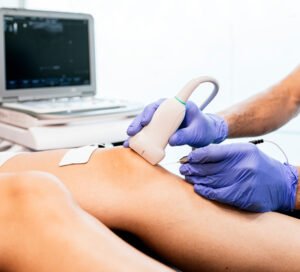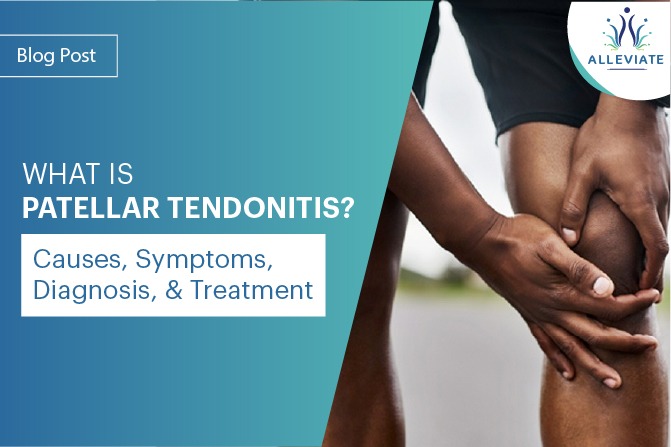Introduction
Patellar tendonitis, also known as jumpers knee, is a common and often painful condition that affects the patellar tendon, which connects the kneecap (patella) to the shinbone (tibia). This condition primarily affects athletes and active individuals, but it can also occur in people with repetitive strain on their knees due to various reasons. In this blog, we will explore the causes, symptoms, diagnosis, and treatment options for patellar tendonitis, with an emphasis on PRP (Platelet-Rich Plasma) + Prolotherapy and exercises that can aid in recovery.

Causes of Patellar Tendonitis
- Overuse : Repetitive stress and strain on the patellar tendon, especially from activities that involve jumping and landing, can lead to microtears and inflammation. This is common among athletes involved in sports like basketball, volleyball, and track and field.
- Poor Biomechanics : Abnormalities in knee alignment or gait can increase stress on the patellar tendon, predisposing individuals to tendonitis.
- Muscle Imbalances : Weakness or imbalances in the quadriceps and hamstring muscles can affect the patellar tendon, as these muscles play a crucial role in knee stability.
- Age : Patellar tendonitis is more common in young athletes and active individuals, but it can affect people of all ages.


Symptoms of Patellar Tendonitis
The symptoms of patellar tendonitis can vary in intensity and duration, but they often include:
- Pain just below the kneecap, particularly during activities that involve jumping, running, or squatting.
- Stiffness in the knee, especially after periods of inactivity.
- Tenderness and swelling around the patellar tendon.
- Gradual worsening of pain over time if the condition is left untreated.
Diagnosis of Patellar Tendonitis
Diagnosing patellar tendonitis typically involves a combination of a physical examination, a detailed medical history, and imaging studies. Your healthcare provider may perform tests such as:
- Palpation : The doctor may gently press or palpate the affected area to check for tenderness and pinpoint the source of pain.
- Imaging : X-rays and ultrasound may be used to visualize the condition of the patellar tendon and rule out other knee problems, like fractures or arthritis.
- MRI (Magnetic Resonance Imaging) : An MRI can provide a more detailed view of the patellar tendon, helping to identify the extent of damage or inflammation.
Treatment Options for Patellar Tendonitis
Treatment for patellar tendonitis is typically conservative, focusing on reducing pain, inflammation, and promoting healing. Some of the common treatment options include:
- Rest : Reducing or avoiding activities that exacerbate the condition can help in the healing process.
- Ice : Applying ice to the affected area can help reduce pain and swelling.
- Physical Therapy : Physical therapy is often recommended to strengthen the quadriceps and hamstring muscles, correct biomechanical issues, and improve flexibility.
- Non-Steroidal Anti-Inflammatory Drugs (NSAIDs) : Over-the-counter or prescription medications can help reduce pain and inflammation.
- PRP + Prolotherapy : Platelet-Rich Plasma (PRP) therapy involves injecting a concentrated solution of the patient’s own platelets into the affected area to stimulate healing. Prolotherapy, on the other hand, uses a solution to induce a controlled inflammatory response, promoting tissue repair. At Alleviate Pain Clinic, we have seen excellent results with Prp & Prolotherapy in the treatment of patellar tendonitis by accelerating the healing process and reducing pain. These treatments are gaining popularity in sports medicine and orthopedics, but it’s essential to consult a healthcare provider to determine their suitability for your condition.


Exercises for Patellar Tendonitis


In addition to medical interventions, a well-structured exercise program is crucial for the rehabilitation of patellar tendonitis. Here are some exercises that can help:
- Eccentric Exercises : Eccentric exercises involve lengthening the muscle under tension. For patellar tendonitis, eccentric squats and leg presses can be beneficial. These exercises help to strengthen the tendon while reducing the risk of overuse.
- Straight Leg Raises : This exercise targets the quadriceps muscles, which play a vital role in knee stability. It can be performed while lying on your back.
- Wall Sits : Wall sits help strengthen the quadriceps and improve endurance. It involves sitting against a wall with your knees bent at a 90-degree angle.
- Hamstring Curls : Strengthening the hamstring muscles can help improve overall knee stability. Hamstring curls can be performed using resistance bands or a leg curl machine.
Conclusion
Patellar tendonitis can be a challenging condition, especially for athletes and active individuals. However, with the right approach to treatment and rehabilitation, many people can successfully recover and return to their active lifestyles. While conservative treatments like rest, physical therapy, and NSAIDs remain effective, emerging therapies like PRP + Prolotherapy offer exciting possibilities for enhanced recovery. Remember that a personalized treatment plan, under the guidance of a healthcare provider, is crucial to manage patellar tendonitis effectively. Additionally, a well-structured exercise program can play a significant role in the rehabilitation process. Always consult with a medical professional for a proper diagnosis and treatment plan tailored to your specific needs.
References
- Khan, Karim M., et al. Patellar tendinopathy: some aspects of basic science and clinical management. British Journal of Sports Medicine 36.5 (2002): 349-366.
- Cook, Jill L., and Craig R. Purdam. Is compressive load a factor in the development of tendinopathy?. British Journal of Sports Medicine 46.3 (2012): 163-168.
- Dragoo, Jason L., et al. Platelet-rich plasma as a treatment for patellar tendinopathy: a double-blind, randomized controlled trial. The American Journal of Sports Medicine 42.3 (2014): 610-618.
- Image taken from- https://www.verywellhealth.com/exercises-for-patellar-tendonitis-5200332



